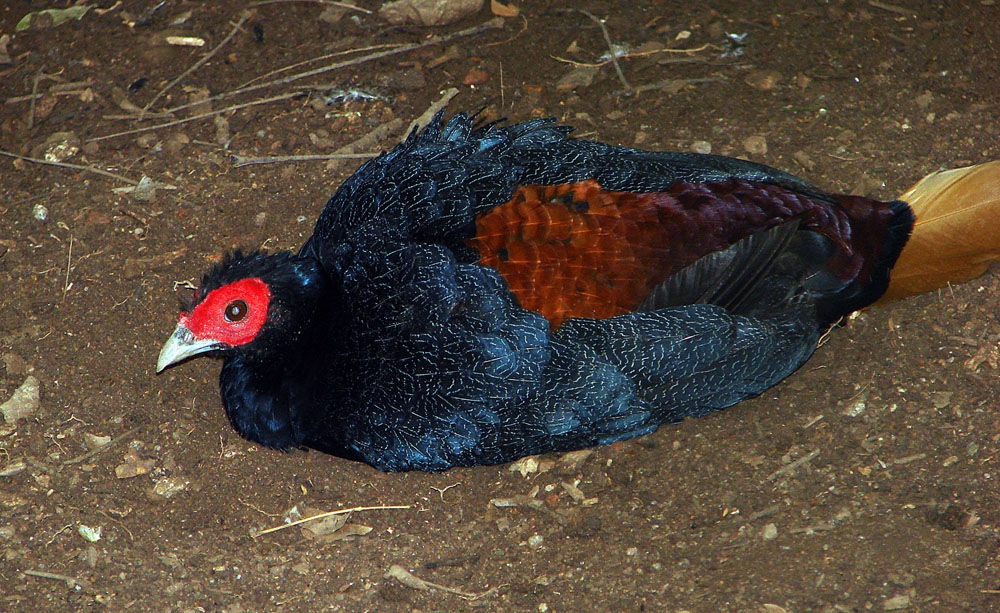| Citation |
|
Description |
Geographic Range [top]
Range Description: Lophura erythrophthalma occurs in Peninsular and East Malaysia, and Sumatra, Indonesia (del Hoyo et al. 1994, Johnsgard 1999). There are just a handful of recent records from Sumatra, all from Riau and Jambi provinces. At select sites it has been recorded at densities of up to six birds per km2 (Johnsgard 1999). However, it is not a widespread species and appears to be localised, suggesting the total population is moderately small, although it is probably under-recorded owing to its occurrence in less accessible peat forest and karst forest (B. van Balen in litt. 2012). Continuing forest clearance throughout the Indonesian lowlands must be causing a rapid decline, which is also likely to be the case outside well-protected areas in Peninsular Malaysia (BirdLife International 2001).
Countries occurrence:
Native:
Indonesia; Malaysia
Regionally extinct:
Singapore
Additional data:
? Continuing decline in area of occupancy (AOO): Yes
? Extreme fluctuations in area of occupancy (AOO): No ? Estimated extent of occurrence (EOO) - km2: 864000
? Continuing decline in extent of occurrence (EOO): Yes ? Extreme fluctuations in extent of occurrence (EOO): No
? Number of Locations: 11-100 ? Continuing decline in number of locations: Yes
? Extreme fluctuations in the number of locations: No
? Upper elevation limit (metres): 300
Range Map: Click here to open the map viewer and explore range.
Population [top]
Population: The population size is preliminarily estimated to fall into the band 10,000-19,999 mature individuals, although it is now likely to be at the lower end of this range (B. van Balen in litt. 2012). An estimate of 10,000-19,999 mature individuals equates to 15,000-29,999 individuals in total, rounded here to 15,000-30,000 individuals.
Trend Justification: This species is threatened by rapid habitat loss and probably hunting pressure, and is consequently suspected to be declining rapidly.
Current Population Trend: Decreasing
Additional data:
? Number of mature individuals: 10000-19999 ? Continuing decline of mature individuals: Yes
? Extreme fluctuations: No ? Population severely fragmented: No
? No. of subpopulations: 2-100 ? Continuing decline in subpopulations: Yes
? Extreme fluctuations in subpopulations: No ? All individuals in one subpopulation: No
Habitat and Ecology [top]
Habitat and Ecology: It is an extreme lowland specialist, inhabiting primary and well-regenerated, closed canopy, evergreen forest. Birds in Malaysia are tolerant of logged forest, and it has been recorded in lightly logged forest on Sumatra at densities of 6 birds/km2 (Johnsgard 1999). However, precise details of its habitat preferences, and its ecological interactions with its congener L. rufa, are lacking. Where L. rufa populations increase, L. erythrophthalma appears to be excluded and the two species appear to have non-overlapping ranges (Johnsgard 1999).
Systems: Terrestrial
Continuing decline in area, extent and/or quality of habitat: Yes
Generation Length (years): 5
Movement patterns: Not a Migrant
Threats [top]
Major Threat(s): The overriding threats are habitat loss, degradation and fragmentation as a result of large-scale commercial logging, even within some protected areas, and widespread clearance for plantations of rubber and oil-palm. Rates of forest loss in the Sundaic lowlands have been extremely rapid (Sumatra lost almost 30% of its evergreen forest during 1985-1997), because of a variety of factors, including the escalation of illegal logging and land conversion. A significant issue currently is selective logging in an array of forest reserves (not protected areas per se) that results in habitat degradation, including degradation of any unknown features that influence habitat selection by this species, and opens the forest to fire risk, reduced value, and conversion to agriculture in future. Hunting for food may pose an additional, more localised threat.
Conservation Actions [top]
Conservation Actions: Conservation Actions Underway
It occurs in several protected areas, including Taman Negara and Krau Wildlife Reserve (Malaysia). The European captive population is not thought to be currently viable in the long term due to diminishing genetic diversity (A. Hennache in litt. 2004).
Conservation Actions Proposed
Advocate full protection under Indonesian and Malaysian law. Conduct further research into its ecological requirements, including its relationship with L. ignita. Conduct extensive field surveys to establish its distribution and population status in Sumatra and assess its use of recently burned areas Following surveys and GIS analysis, review whether key populations are adequately represented within the existing protected areas network, and advocate protection of further areas if necessary. Assist forest managers in habitat identification and zoning of concession areas. Develop support mechanisms for key IBAs in Peninsular Malaysia. Promote the careful management of captive stocks including the establishment of a studbook to re-establish a viable captive-breeding programme.
Citation: BirdLife International. 2016. Lophura erythrophthalma. The IUCN Red List of Threatened Species 2016: e.T22727411A94948310. http://dx.doi.org/10.2305/IUCN.UK.2016-3.RLTS.T22727411A94948310.en. Downloaded on 15 May 2017.
Disclaimer: To make use of this information, please check the .
Feedback: If you see any errors or have any questions or suggestions on what is shown on this page, please provide us with feedback so that we can correct or extend the information provided
|

